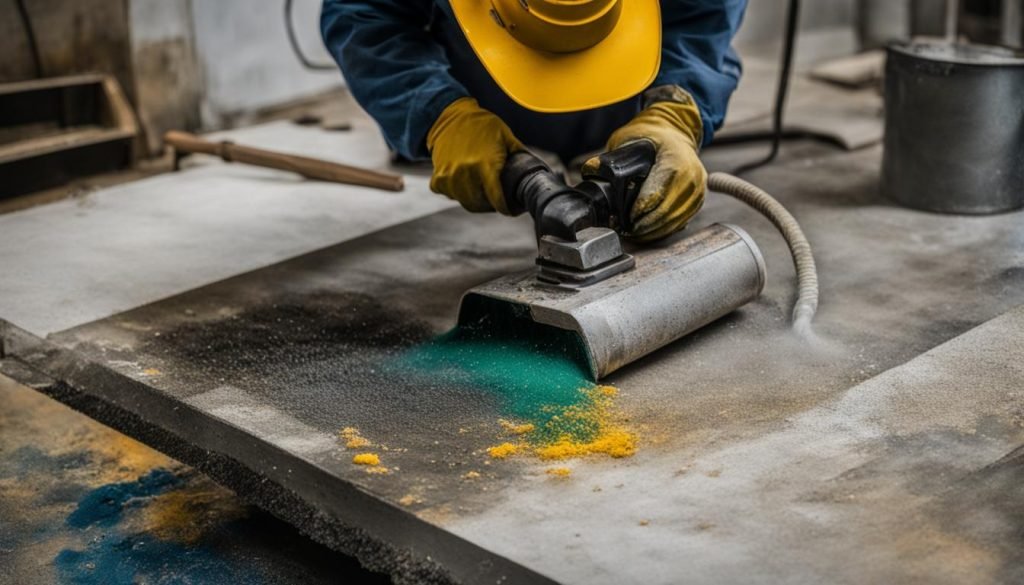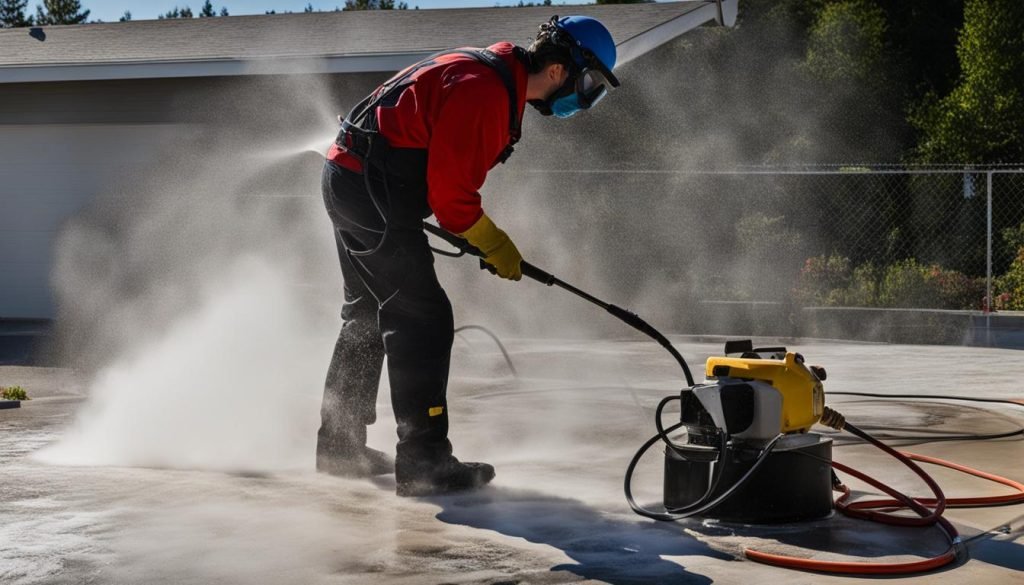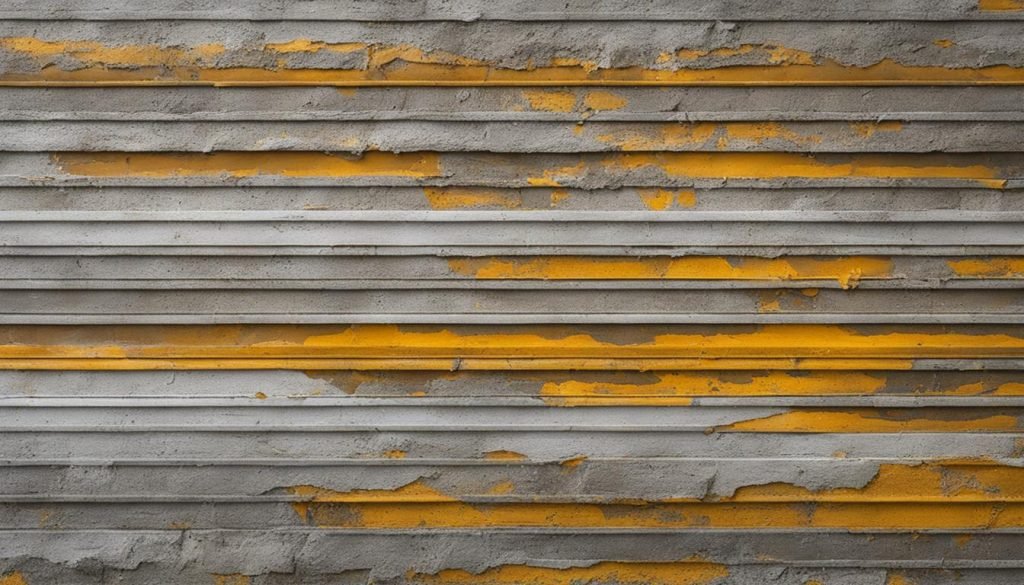Removing paint from concrete can be a challenging task, but with the right techniques, it can be done effectively. Whether you want to remove paint from a concrete floor, walls, or any other surface, there are various methods available to suit different situations. In this detailed guide, we will walk you through step-by-step instructions on how to strip paint from concrete surfaces. Check out our Experienced concrete contractors in Toowoomba, delivering quality workmanship. Broaden your construction skills with this comprehensive guide on How to Build a Deck on Concrete Slab: Step-by-Step Guide. Explore valuable insights and step-by-step guidance for success in building a deck on a concrete slab.
Key Takeaways:
- There are multiple methods to strip paint from concrete, including using chemical strippers, power washing, soda blasting, and grinding.
- Chemical strippers are effective for removing both water-based and oil-based paints. Choose the correct stripper based on the type of paint you want to remove.
- Power washing with a high-pressure washer is suitable for outdoor concrete surfaces like driveways and patios.
- Soda blasting is a quick and less aggressive method for removing multiple layers of paint without damaging the concrete.
- Grinding is ideal for thin coatings and paints on concrete floors, but proper safety precautions should be taken.
Using Chemical Strippers for Paint Removal
When it comes to removing paint from concrete surfaces, chemical strippers can be a highly effective method. The key to success lies in choosing the right stripper formulated for the specific type of paint you’re dealing with, whether it’s water-based or oil-based.
Here’s a step-by-step guide on how to strip paint from a concrete floor using chemical strippers:
- Begin by preparing the area by covering nearby furniture, plants, and delicate surfaces to protect them from the stripper.
- Apply a thick, even layer of the chosen chemical stripper to the painted concrete surface. Use a brush or roller to ensure complete coverage.
- Allow the stripper to penetrate and soften the paint. The required waiting time may vary depending on the stripper and the paint’s thickness. Follow the manufacturer’s instructions for the best results.
- After the waiting period, use a scraper or wire brush to gently scrape off the softened paint. Start from one edge of the painted area and work your way across, being careful not to damage the concrete surface.
- If there are stubborn areas where the paint is still clinging, reapply the stripper and let it work for a longer period. Use a scraper or wire brush to remove the remaining paint.
- Once all the paint has been removed, thoroughly clean the concrete surface with a degreaser to remove any residue and ensure a clean, paint-free finish.
Note: Always wear protective gloves, goggles, and a mask when working with chemical strippers to protect yourself from potentially harmful fumes and chemicals.
Check out the table below for an overview of the pros and cons of using chemical strippers for paint removal on concrete:
| Pros | Cons |
|---|---|
| Effective for removing various types of paint | Chemicals can be harmful to the environment |
| Allows for precise application | May require multiple applications for complete paint removal |
| Does not damage the concrete surface when used correctly | Can be time-consuming |
The Importance of Proper Safety Precautions
When using chemical strippers, it’s crucial to prioritize safety. Make sure to:
- Read and follow the instructions provided by the manufacturer.
- Wear appropriate protective gear, including gloves, goggles, and a mask.
- Work in a well-ventilated area or use a fan to circulate fresh air.
- Dispose of used stripper and paint residues according to local regulations.
Remember, chemical stripping is just one of the many methods available for removing paint from concrete. In the next section, we’ll explore the power washing technique as another option for effective paint removal.
Power Washing for Concrete Paint Removal
If you’re looking for an effective method to remove paint from concrete, especially on exterior surfaces like driveways and patios, power washing can be a great option. Using a power washer can help loosen and remove paint from concrete surfaces with its high-pressure water stream. To achieve the best results, it is recommended to use a power washer with a pressure rating of at least 3000 psi and a flow rate of at least 4 gallons per minute.
When using a power washer for concrete paint removal, it is important to exercise caution and follow safety guidelines. Incorrect use can potentially cause damage to the concrete surface. Take note of the following tips to ensure a successful power washing process:
- Begin by preparing the area by removing any loose debris or dirt from the concrete surface.
- Connect the power washer to a suitable water source and ensure that it is properly functioning.
- Hold the power washer nozzle at a distance of approximately 6 to 12 inches from the concrete surface.
- Move the nozzle in a back-and-forth motion, covering the entire painted area evenly.
- Pay extra attention to stubborn paint spots and adjust the nozzle pressure accordingly.
- Once the paint has been loosened, use a scraper or a brush to remove the paint chips.
- After the power washing process, thoroughly clean the area and rinse it with water to remove any remaining paint particles or residue.
Remember, power washing can be an effective method for removing paint, but it may not completely eliminate all paint layers or stubborn stains. In some cases, a combination of different techniques may be required for the best results.
Benefits of Power Washing for Concrete Paint Removal
Power washing offers several advantages as a method for removing paint from concrete surfaces:
- Efficiency: The high-pressure water stream of a power washer can effectively loosen and remove paint from concrete.
- Time-saving: Power washing can cover large areas more quickly compared to manual methods.
- Versatility: Power washers can be used on various concrete surfaces, such as driveways, patios, walls, and more.
- No chemicals: Power washing relies solely on water, making it an environmentally friendly option.
However, it is important to note that power washing may not be suitable for all concrete surfaces or paint types. Delicate or fragile surfaces should be approached with caution to avoid any potential damage. If uncertain, it is advisable to seek professional advice.
Power washing can be an effective and efficient method for removing paint from concrete surfaces. By following the proper techniques and safety guidelines, you can restore the appearance of your concrete and achieve successful paint removal results.
Soda Blasting for Paint Removal
When it comes to removing paint from concrete surfaces, soda blasting is a highly effective method that uses granular sodium bicarbonate (baking soda). This process involves blasting the soda at high pressure onto the concrete surface, effectively stripping away layers of paint or coatings. Unlike sandblasting, soda blasting is a less-aggressive method that does not damage the concrete surface.
Soda blasting is particularly beneficial for removing multiple layers of paint or coatings quickly and efficiently. It is a versatile technique that can be used on various surfaces, including concrete floors, walls, and even delicate materials like metal or wood.
To carry out soda blasting, specialized equipment is required, including a soda blaster and an air compressor. The blasting process is carefully controlled, ensuring that the right pressure and soda flow rate are maintained. This allows for precise and effective paint removal while minimizing any potential damage to the underlying concrete surface.
“Soda blasting is a highly effective and safe method for removing paint from concrete surfaces. It offers quick results and is suitable for both small-scale and large-scale paint removal projects.”
One of the key advantages of soda blasting for paint removal is that it is a non-toxic and environmentally friendly option. Baking soda is a natural compound that is safe to use and does not release harmful chemicals or fumes into the air during the stripping process.
However, it is important to note that soda blasting equipment requires skill and expertise to operate properly and safely. For this reason, it is recommended to hire a professional service that specializes in soda blasting for paint removal. These professionals have the necessary experience and equipment to ensure a thorough and efficient paint stripping process.
Overall, soda blasting is an effective method for removing paint from concrete surfaces. It offers quick and efficient results while minimizing damage to the underlying concrete. If you are considering paint stripping on concrete, especially for large-scale projects, hiring a professional soda blasting service is the recommended approach to achieve the best possible outcome.
Benefits of Soda Blasting for Paint Removal:
- Effective in removing multiple layers of paint or coatings
- Does not damage the concrete surface
- Non-toxic and environmentally friendly
- Suitable for various surfaces, including concrete, metal, and wood
- Quick and efficient paint removal process
Grinding for Paint Removal on Concrete Floors

When it comes to concrete paint removal, grinding is a highly effective method for stripping paint from concrete floors. This technique is particularly suitable for removing thin coatings and paints, as well as for cleaning and lightly abrading concrete surfaces. By using a walk-behind or handheld concrete grinder, you can achieve excellent results in paint removal.
The process involves using specialized grinding disks, which can be rented from home improvement stores and equipment rental companies. These disks are specifically designed to efficiently remove paint from concrete surfaces. It is important to follow safety guidelines when using a concrete grinder, ensuring that you wear protective gear such as goggles, a dust mask, and earplugs.
The grinder should be equipped with a vacuum port to control airborne dust particles and minimize the mess. This not only ensures a cleaner working environment but also reduces the risk of inhaling harmful dust. It is recommended to start with a coarse grinding disk to effectively remove the paint, and then switch to a finer disk to achieve a smooth and even surface.
Step-by-Step Guide to Grinding Paint off Concrete Floors:
- Prepare the area by removing any furniture or obstructions.
- Clean the floor thoroughly to remove any loose dirt and debris.
- Attach a coarse grinding disk to the concrete grinder and start grinding the painted areas. Move the grinder in a back-and-forth motion and apply even pressure to ensure consistent paint removal.
- Continue grinding until all the paint has been stripped off the concrete floor.
- Switch to a finer grinding disk and repeat the process to achieve a smooth and polished surface.
- Once the paint has been completely removed, clean the floor with a broom or vacuum to remove any residual dust.
Grinding is a versatile method that not only removes paint but also prepares the concrete surface for new coatings or finishes. It is an ideal solution for both residential and commercial projects, providing a durable and aesthetically pleasing result.
“Grinding is a highly effective method for removing paint from concrete floors. It allows for precise control and can be used to achieve a smooth and polished finish.”
| Pros | Cons |
|---|---|
| Effective for removing thin coatings and paints | May require multiple passes for complete paint removal |
| Creates a smooth and polished surface | Produces dust, requiring proper safety precautions |
| Ideal for preparing concrete surfaces for new coatings | Requires renting or purchasing a concrete grinder |
| Can be used for both residential and commercial projects | May leave visible grind marks on the concrete surface |
Resurfacing as a Paint Removal Option
If all other methods fail to completely remove paint from a concrete surface, resurfacing can be considered as an alternative. Resurfacing involves applying a new coating or layer over the old surface, giving a clean canvas to work with. This allows you to choose new colors, textures, and patterns for your concrete. However, it is important to properly prepare the concrete surface before applying a new coating to ensure proper adhesion and longevity.
Why Choose Resurfacing?
When traditional paint removal methods prove ineffective or impractical, resurfacing can offer a solution. By covering the existing paint with a new layer, you can achieve a fresh and vibrant look for your concrete surface. Here are a few reasons why resurfacing may be the right choice:
- Complete coverage: Resurfacing covers up all traces of the old paint, ensuring a uniform appearance.
- Customization: With a new layer, you have the freedom to choose new colors, textures, and patterns that suit your style and preferences.
- Renewed durability: The new coating provides added protection and durability, extending the lifespan of your concrete surface.
- Cost-effective: Resurfacing can be a cost-effective alternative to extensive paint removal or full concrete replacement.
The Resurfacing Process
Resurfacing a painted concrete floor involves several steps to ensure a successful outcome. Here is an overview of the process:
- Preparation: Start by thoroughly cleaning the concrete surface, removing any dirt, grease, or loose paint. Repair any cracks or damaged areas with a suitable concrete repair product.
- Primer application: Apply a primer to promote adhesion between the old paint and the new coating. Follow the manufacturer’s instructions for the specific primer product you choose.
- Coating application: Once the primer has dried, apply a concrete resurfacer or overlay. Use a trowel or squeegee to spread the material evenly, ensuring a smooth and consistent coating.
- Decorative options: If desired, add decorative elements such as color flakes, stains, or stencils while the coating is still wet. This is an opportunity to personalize the appearance of your resurfaced concrete.
- Curing and finishing: Allow the coating to dry and cure according to the manufacturer’s instructions. Finish the process by applying a sealant or topcoat to enhance the appearance and protect the new surface.
Keep in mind that resurfacing is best suited for surfaces with minor paint issues or areas where complete paint removal is not feasible. For larger-scale paint removal projects or heavily damaged surfaces, consulting with a professional contractor is recommended to ensure optimal results.
By choosing resurfacing as a paint removal option, you can transform the look of your concrete surface, leaving behind the old paint and embracing a fresh new design.
| Advantages of Resurfacing | Considerations for Resurfacing |
|---|---|
| 1. Complete coverage of old paint | 1. The paint removal process may still be required for heavily damaged or textured surfaces. |
| 2. Customization options for colors, textures, and patterns | 2. The existing paint must be in good condition and not peeling or flaking excessively. |
| 3. Enhanced durability and protection for the concrete surface | 3. Resurfacing may add thickness to the concrete surface, affecting transitions with surrounding areas. |
| 4. Cost-effective alternative to paint removal or full concrete replacement | 4. Proper surface preparation is crucial for a successful resurfacing project. |
Tips for Removing Water-Based Paint from Concrete

Removing water-based paint from concrete surfaces requires a systematic approach to ensure effective results. Follow these tips and techniques for a successful paint removal process:
Step 1: Thoroughly Clean the Surface
Prior to paint removal, it is crucial to clean the concrete surface thoroughly to eliminate loose dust, debris, and any contaminants. This ensures that the paint removal process is more efficient and effective. Use a stiff-bristle brush or a broom to sweep away loose particles. For stubborn dirt or stains, consider using a pressure washer.
Step 2: Dissolve and Lift the Paint
One effective way to remove water-based paint from concrete surfaces is by using a solution of methylated spirits. Methylated spirits are solvents that can effectively dissolve and lift the paint from the surface.
“Applying a solution of methylated spirits can help dissolve and lift water-based paint from concrete surfaces.”
To use methylated spirits for paint removal, follow these steps:
- Apply the methylated spirits directly onto the painted area.
- Allow the spirits to sit and penetrate the paint for a few minutes.
- Use a scraper or a stiff brush to gently scrape away the softened paint.
- Continue this process until all the paint has been removed.
Step 3: Rinse the Surface
After successfully removing the water-based paint, it is important to rinse the concrete surface thoroughly to remove any remaining residue. Use clean water and a hose or pressure washer to rinse the area.
Step 4: Addressing Persistent Stains
If there are still paint stains remaining on the concrete after following the previous steps, additional measures can be taken. Consider using a pressure washer with an appropriate nozzle to further clean the concrete surface. This can help remove any bleached or stained areas caused by the paint.
An image depicting the process of removing paint from concrete surfaces.
Step 5: Clean and Prepare for Next Steps
After removing the water-based paint from the concrete surface, it is essential to clean the area thoroughly and prepare it for any additional steps, such as sealing or refinishing. Remove any debris or residue left behind from the paint removal process to ensure a clean and smooth surface.
| Pros: |
|
|---|---|
| Cons: |
|
Steps for Removing Oil-Based Paint from Concrete
Removing oil-based paint from concrete surfaces may require a bit more effort compared to other paint types. Follow these step-by-step instructions to effectively remove oil-based paint from concrete:
- Step 1: Scrape away as much paint as possible using a paint scraper or brush. Be careful not to damage the concrete surface while scraping.
- Step 2: Apply turpentine (turps) to the remaining paint residue. Allow it to sit for a few minutes to soften the paint.
- Step 3: Using a stiff-bristle brush, vigorously scrub the turpentine into the paint. This will help dissolve and lift the paint from the concrete.
- Step 4: Rinse the treated area with clean water to remove any loosened paint and turps residue.
- Step 5 (Optional): If necessary, use a pressure washer for a more thorough cleaning. Ensure the pressure washer is suitable for use on concrete and follow the manufacturer’s instructions.
Following these steps will help you remove oil-based paint from concrete surfaces effectively. The use of turps and scrubbing will help break down the paint, making it easier to rinse away. Remember to take necessary precautions and ensure proper ventilation when using turpentine or pressure washers.
If you’re unsure about handling oil-based paint removal on your own, it’s always a good idea to consult with professionals who specialize in concrete paint removal.
Using Absorbent Materials for Paint Removal
Absorbent materials can be a useful and effective solution for removing paint from concrete surfaces. By creating a custom paint remover using ground clay and paint stripper, you can tackle stubborn paint stains with ease. Here’s how to do it:
- Mix ground clay and paint stripper together to form a thick paste.
- Apply the paste onto the paint stains, ensuring full coverage.
- Allow the paste to dry and work on the paint. This may take several hours.
- Once dry, the paste will have loosened the paint, making it easier to remove.
- Scrape off the paste along with the loosened paint using a scraper or wire brush.
- Use scrubbing powder to further clean the area and remove any residual paint particles.
This method is particularly effective for smaller areas or localized paint stains. It provides an eco-friendly and cost-effective alternative to chemical strippers or other removal methods. However, it’s important to note that absorbent materials may not be suitable for large-scale paint removal projects or surfaces with multiple layers of paint.
Benefits of Using Absorbent Materials for Paint Removal
Using absorbent materials for paint removal offers several advantages:
- Eco-friendly: This method avoids the use of harsh chemicals, making it a more sustainable option.
- Cost-effective: Ground clay and paint stripper are readily available and affordable.
- Localized application: Absorbent materials allow you to target specific paint stains without affecting the surrounding areas.
However, it’s important to consider the limitations of this method. Absorbent materials may not be suitable for larger paint removal projects or surfaces with thick layers of paint. In such cases, professional assistance or alternative methods may be required.
Applying Sealer to Prevent Paint Absorption
To prevent paint absorption and make future paint removal easier, it is recommended to apply a sealer or floor wax to the concrete surface. Sealing the concrete creates a protective barrier that prevents paint from penetrating and staining the surface. Before applying the sealer, the concrete should be thoroughly cleaned and any cracks filled with a concrete filler. This helps to ensure a smooth and even surface for the sealer to adhere to.
Applying a sealer not only safeguards the concrete from paint absorption but also helps in maintaining its durability and aesthetics. The sealer forms a transparent layer that acts as a shield against moisture, chemicals, and other external factors that can damage the concrete surface.
“By sealing the concrete, you can significantly prolong its lifespan and reduce the need for frequent repainting or refinishing,” says Roger Johnson, a renowned expert in concrete restoration. He recommends using a high-quality concrete sealer that is specifically designed for protecting painted concrete surfaces.
Here is a step-by-step guide to properly apply a sealer to prevent paint absorption on concrete:
- Clean the concrete: Remove any dirt, oil, or debris from the concrete surface using a degreaser or mild detergent. Rinse thoroughly with water and allow it to dry completely.
- Fill cracks: Inspect the concrete for any cracks or gaps and fill them with a concrete filler. Smooth out the filled areas to ensure an even surface.
- Select the right sealer: Choose a high-quality concrete sealer that is suitable for painted concrete surfaces. Consider factors such as the type of paint, level of protection required, and environmental conditions.
- Apply the sealer: Follow the manufacturer’s instructions for mixing and applying the sealer. Use a roller or a brush to evenly distribute the sealer on the concrete surface. Allow the sealer to penetrate and dry according to the recommended drying time.
- Apply additional coats: Depending on the level of protection required, apply additional coats of sealer after each layer has dried. This will enhance the durability and longevity of the sealer.
- Cure the sealer: Allow the sealer to cure for the recommended time before subjecting the concrete to heavy foot traffic or other activities.
By applying a sealer to the concrete surface, you can prevent paint absorption and ensure that future paint removal becomes a much easier task. Furthermore, the sealed concrete will have a longer lifespan, maintain its aesthetics, and resist various forms of damage.
| Benefits of Applying a Sealer to Prevent Paint Absorption |
|---|
| Provides a protective barrier against paint absorption |
| Preserves the durability and aesthetics of the concrete |
| Reduces the need for frequent repainting or refinishing |
| Prevents moisture, chemical, and other damage to the concrete surface |
Conclusion
Removing paint from concrete surfaces can be a challenging task, but with the right techniques and tools, it is definitely achievable. Whether you opt for chemical strippers, power washing, soda blasting, grinding, or other methods, it is essential to prioritize safety and take the necessary precautions. Each method has its own advantages and limitations, so choose the approach that suits your specific needs.
By following the step-by-step instructions outlined in this detailed guide, you can successfully strip paint from concrete surfaces and restore their original appearance. Remember to carefully select the appropriate method based on the type of paint and the size of the area to be treated. If you are uncertain or have a large-scale paint removal project, it is always advisable to consult with professionals for expert advice and assistance.
With perseverance, patience, and the right techniques, you can achieve remarkable results in concrete paint removal. By uncovering the hidden beauty beneath layers of old paint, you can transform the look of your concrete surfaces and create a fresh canvas for your next project. Good luck!
FAQ
How can I strip paint from concrete?
There are several methods for stripping paint from concrete, including using chemical strippers, power washing, soda blasting, and grinding. Follow our step-by-step guide for detailed instructions.
Can I use chemical strippers to remove paint from concrete?
Yes, chemical strippers can be effective for removing paint from concrete surfaces. Choose a stripper that is suitable for the type of paint you are removing, apply it to the surface, let it penetrate, and then scrape off the softened paint.
How do I remove paint from concrete with a power washer?
A power washer with a pressure rating of at least 3000 psi and a flow rate of at least 4 gallons per minute can be used to remove paint from concrete. Be careful to follow safety guidelines and use the appropriate pressure to avoid causing damage.
What is soda blasting, and how does it remove paint from concrete?
Soda blasting involves blasting granular sodium bicarbonate (baking soda) at high pressure onto the concrete surface to remove paint. It is a less aggressive method compared to sandblasting and is effective for removing multiple layers of paint or coatings without damaging the concrete.
Can I use grinding to remove paint from concrete floors?
Yes, grinding is an effective method for removing paint from concrete floors. Use a walk-behind or handheld concrete grinder with specialized grinding disks to remove thin coatings and paints and clean the surface. Take safety precautions and control dust with a vacuum port.
Is resurfacing a viable option for paint removal on concrete?
If other methods fail, resurfacing can be considered. Applying a new coating or layer over the old surface can create a clean canvas for new colors and patterns. However, proper surface preparation is necessary for adhesion and longevity.
How can I remove water-based paint from concrete?
Start by cleaning the surface thoroughly and removing loose dust and debris. Use a solution of methylated spirits to dissolve and lift the paint, then rinse with water. For stubborn stains, a pressure washer can provide a more thorough cleaning.
What is the process for removing oil-based paint from concrete?
Scrape away as much paint as possible with a paint scraper or brush. Apply turps to the remaining paint residue and scrub vigorously with a brush. Rinse with water, and if needed, use a pressure washer for further cleaning.
Can absorbent materials remove paint from concrete?
Yes, you can create a custom paint remover using ground clay and paint stripper. Mix them to form a thick paste and apply it to the paint stains. Once the paste dries, scrape it off along with the loosened paint. Use scrubbing powder to clean any residual paint particles.
How can I prevent paint absorption on concrete?
Apply a sealer or floor wax to the concrete surface to create a protective barrier against paint absorption. Clean the concrete beforehand and fill any cracks with a concrete filler for a smooth surface that enhances adhesion.
What are the best tips for paint removal from concrete?
The best tips for paint removal from concrete include using the right method for paint type and surface, following safety guidelines, and seeking professional assistance for large-scale projects or specialized methods.




